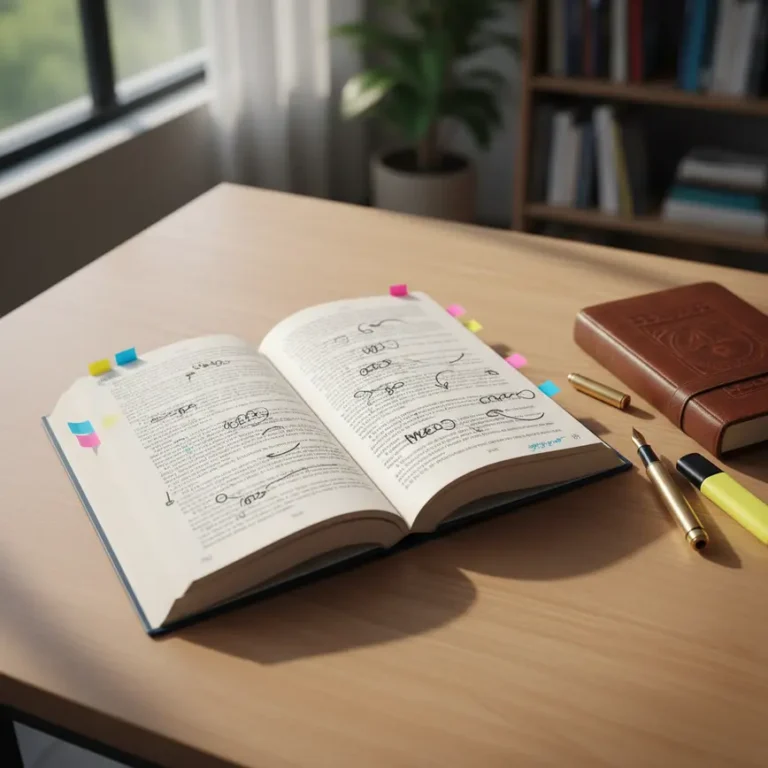
🔑 Key Takeaway
A literary analysis is an argument about a work of literature that examines how its individual parts contribute to its overall meaning.
- It involves interpreting a text, not just summarizing the plot.
- Key elements to analyze include plot, character, setting, theme, and tone.
- A strong analysis is built on a debatable thesis statement supported by evidence from the text.
Read on for a complete guide on how to conduct one, with examples from a contemporary author.
Literary analysis is the art of breaking down a text to understand how its parts work together to create a cohesive whole. It moves beyond a simple book report to uncover deeper meanings and authorial intent. Whether you’re a student, an aspiring writer, or a passionate reader, learning this skill can profoundly enrich your appreciation for literature. This guide will teach you the fundamentals of how to perform a literary analysis, using clear steps and practical examples.
We’ll explore the key elements to look for in any text and walk through the process of writing a formal analysis essay. To make these concepts concrete, we will apply them to the work of contemporary author Claudio Gaudio, showing how these academic principles and author themes work in modern novels. Let’s begin by defining what a literary analysis truly is.
ℹ️ Transparency
This article explores the principles of literary analysis based on established academic standards. All information is based on verified sources and reviewed by an expert. Our goal is to inform you accurately.
What is Literary Analysis?
Literary analysis is the process of examining a piece of literature to understand how its various components—such as plot, character, and theme—work together to create its meaning and effect. It is an argument-driven interpretation, not just a factual summary of the story. The goal of a literary analysis definition is to move beyond “what happened” to explore “how” and “why” the author crafted the text in a specific way. To better understand this, it’s crucial to distinguish it from a more common form of writing about books.
The Difference Between Literary Analysis and a Book Report
A book report or plot summary recounts the events of the story. A literary analysis presents a debatable claim about the story’s meaning and uses textual evidence to support that claim. For instance, a resource from Austin Peay State University’s Writing Center clarifies this, stating, “A plot summary is a brief description of a story’s plot… A literary analysis, on the other hand, is an argument…” [2]. A summary states that a character acted, while an analysis explores why they acted that way and what it reveals about a larger theme.
Why is Literary Analysis Important?
This practice develops critical thinking skills by encouraging readers to look beyond the surface of a text. This enhances reading comprehension, deepens appreciation for the art of writing, and helps readers understand the complex ways literature reflects and shapes human experience. Research published in Cosmos Journals suggests that studying literary techniques is important for understanding the interpretation and meaning of literary works [5].
Key Elements of Literary Analysis
To conduct a thorough analysis, you must examine several core components of a text. These elements of literary analysis are the building blocks the author uses to construct their narrative and convey meaning.
Plot and Structure
Plot refers to the sequence of events in a story. When analyzing plot, consider how the arrangement of these events (e.g., chronological, flashbacks) builds suspense, develops conflict, and leads to a resolution. Structure is how the narrative is organized.
Character and Point of View
Characters are the individuals who inhabit the story. Analysis involves examining their motivations, conflicts, and development over time. Point of View (first-person, third-person) determines who is telling the story and shapes the reader’s perception of events. A study in the Alamo Colleges Writing Center, a theme is “The message/es explored throughout a work of literature” [3]. Tone is the author’s attitude toward the subject, conveyed through word choice and sentence structure.
How to Write a Literary Analysis Essay
Writing a literary analysis essay can be broken down into a series of manageable steps. Following a clear process for a literary analysis essay ensures your argument is focused, well-supported, and effectively communicated.
Step 1: Choose a Focus and Develop a Thesis
Don’t try to analyze everything. Choose a specific element—like a character’s development, a recurring symbol, or the narrative structure. Your thesis statement is the central argument you will prove. It should be specific, debatable, and focused on interpretation. As explained in an educational video from organize your research and arguments.
Step 4: Write the Introduction, Body, and Conclusion
- Introduction: Grab the reader’s attention, introduce the text and author, and state your thesis.
- Body Paragraphs: Start each with a topic sentence that presents a point supporting your thesis. Then, provide your evidence (quote/paraphrase) and explain how it supports the topic sentence and the overall thesis.
- Conclusion: Restate your thesis in new words, summarize your main points, and offer a final thought on the text’s significance.
Literary Analysis in Action: Themes and Inspirations in Claudio Gaudio’s Novels
Theory is helpful, but seeing a literary analysis in practice makes it click. Let’s apply these concepts to the work of contemporary Toronto-based author Claudio Gaudio to provide a clear literary analysis example. We will explore the recurring author themes and book inspirations in his novels, showcasing how analysis can be approached with contemporary tools for creators.
Analyzing Themes of Identity and Belonging in “Texas”
Thesis: In his novel “Texas,” Claudio Gaudio uses the desolate setting of the Texas landscape as a symbol for the protagonist’s internal struggle with identity and search for belonging.
- Evidence 1 (Setting): The narrative frequently describes the vast, empty spaces and stark horizons, which mirror the main character’s feelings of social and emotional isolation.
- Analysis 1: This deliberate connection between the external setting and the character’s internal state reinforces the central theme. The landscape is not just a backdrop but an active participant in illustrating his loneliness.
- Evidence 2 (Character Actions): The protagonist repeatedly makes impulsive decisions to leave towns and relationships just as they begin to form, demonstrating a pattern of self-sabotage.
- Analysis 2: This behavior can be interpreted as a direct consequence of his unresolved identity. He is unable to find a place to belong because he doesn’t yet understand who he is, linking his actions back to the thesis.
Unpacking the Inspirations Behind “I’ll Be”
Thesis: Gaudio’s “I’ll Be” draws inspiration from classic noir fiction, using its stylistic tropes not for a crime story, but to explore themes of fate and memory in a modern context.
- Evidence 1 (Tone/Style): The novel employs sharp, cynical dialogue and a fatalistic tone, both of which are characteristic of the noir genre. The protagonist often reflects on past mistakes with a sense of inevitability.
- Analysis 1: This stylistic choice creates a mood that aligns with the novel’s thematic exploration of fate. The reader feels the character is trapped by his past, much like a classic noir hero.
- Evidence 2 (Plot Structure): The plot features elements like a mysterious past that slowly unravels and a character who embodies the dangerous allure of a traditional femme fatale.
- Analysis 2: By placing these tropes in a non-criminal context, Gaudio prompts the reader to consider how memory and past choices can ensnare a person. This suggests that the true “crime” in the story is the inability to escape one’s own history.
FAQ – Answering Your Questions About Literary Analysis
What is literary analysis?
A literary analysis is an argument about a literary work that goes beyond simple summary. It involves carefully examining and interpreting a text’s elements, such as theme, character, and symbolism, to make a specific claim about its meaning. The goal is to explain how an author uses these elements to create effects and convey ideas. This process deepens understanding and critical thinking.
What is a literary analysis essay?
A literary analysis essay is a formal piece of academic writing that presents an argument about a piece of literature. It begins with a debatable thesis statement in the introduction, which is then supported with evidence from the text (quotes and paraphrases) in the body paragraphs. The essay’s purpose is not to retell the story, but to prove the writer’s interpretation of it.
What are the elements of literary analysis?
The key elements of literary analysis are the fundamental components of a story that you can examine. These typically include the plot (sequence of events), characters (their traits and development), setting (time and place), point of view (who tells the story), symbolism (objects representing ideas), and theme (the central message). Analyzing how these elements work together is the foundation of a strong interpretation.
How do you write a literary analysis?
To write a literary analysis, first, read the text closely and choose a specific, arguable focus. Develop a thesis statement that presents your main argument. Next, gather textual evidence, like quotes, to support your thesis. Organize your points into an outline, then write the essay with an introduction, body paragraphs for each point, and a conclusion that summarizes your argument.
What is an example of a literary analysis?
An example of a literary analysis is arguing that in “The Great Gatsby,” the green light symbolizes unattainable dreams, not just Daisy. To support this, you would analyze scenes where the light appears, quoting passages that connect it to Gatsby’s broader ambitions beyond just one person. This moves beyond summarizing the symbol’s presence to interpreting its deeper thematic meaning in the novel.
Limitations, Alternatives, and Professional Guidance
It’s important to acknowledge that literary interpretation is subjective; there is rarely one “correct” analysis. Different critical theories (e.g., Feminist, Marxist, Formalist) can lead to vastly different but equally valid interpretations of the same text. This guide focuses on a formalist approach, which prioritizes the text itself, but other lenses offer valuable insights that are not covered here.
Instead of a formal essay, a literary analysis can take other forms. A character study focuses deeply on a single character’s arc. A comparative analysis examines two different texts or characters side-by-side. For less formal exploration, journaling your thoughts or discussing a book with a club can also be powerful ways to analyze its themes and structure without academic pressure.
For students, consulting with a professor, teacher, or university writing center is highly recommended. These experts can provide feedback on your thesis, help you find stronger evidence, and guide you on structuring your argument effectively. Preparing for a consultation by bringing a draft outline and specific questions will likely make the session most productive.
Conclusion
In summary, a literary analysis is a powerful tool for unlocking the deeper layers of meaning within any text. By moving beyond summary to interpretation, you can develop a richer appreciation for the author’s craft. Remember to focus your argument with a strong thesis, support it with textual evidence, and consider the interplay of elements like character, theme, and setting.
At The Tech ABC, we believe that understanding complex systems—whether in technology or in literature—is empowering. We provide practical and accessible guides to help you make sense of the modern world. If you found this guide helpful, consider exploring our other articles on how technology and art intersect.
References
- Texas A&M University Writing Center. (n.d.). Analyzing Novels & Short Stories. Retrieved from https://writingcenter.tamu.edu/writing-speaking-guides/analyzing-novels-short-stories-dca1e62dc095831688f35cf690150f50
- Austin Peay State University Writing Center. (2022). Plot Summary vs. Literary Analysis. Retrieved from https://www.apsu.edu/writingcenter/writing-resources/plot-summary-vs-literary-analysis-handout-2022.pdf
- Alamo Colleges, San Antonio College Writing Center. (n.d.). Elements of a Literary Analysis. Retrieved from https://www.alamo.edu/siteassets/sac/about-sac/college-offices/writing-center/elements-of-a-literary-analysis.pdf
- The Prose Path. (2022, October 2). How to Write a Thesis Statement for a Literary Analysis Essay. YouTube. Retrieved from https://www.youtube.com/watch?v=cmayy_NrpmY
- Paramalingam, M. (2023). The Use of Literary Devices in Selected Short Stories of Shirley Jackson. Cosmos: An International Journal of Art and Higher Education, 4(1). Retrieved from https://cosmosjournals.com/wp-content/uploads/2023/07/CAHE-JD23-122-1.-Muhantha-Paramalingam.pdf
- Sari, D. P., & Sabardila, A. (2020). Character Development of the Main Character in “The Fault in Our Stars” Novel by John Green. Journal of Psychology and Social Behavior, 2(1). Retrieved from https://ejournal.upi.edu/index.php/psg/article/download/21253/pdf_1




